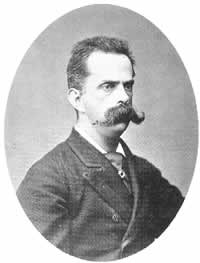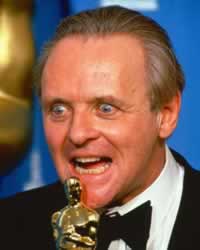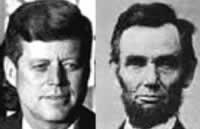Top 15 Strangest Coincidences
Published on 4/17/2006
Mark Twain was born on the day of the appearance ofHalley's Comet in 1835, and died on the day of its next appearance in 1910. He himself predicted this in 1909, when he said: "I came in with Halley's Comet in 1835. It is coming again next year, and I expect to go out with it."
Oregon's Columbian newspaper announced the winning Pick 4 lottery numbers for June 28, 2000 in advance. The newspaper had intended to print the previous set of winning numbers but erroneously printed those for the state of Virginia, namely 6-8-5-5. In the next Oregon lottery, those same numbers were drawn.
In 1979, the German magazine - Das Besteran - ran a writing competition. Readers sent in unusual stories, but they had to be based on true incidents. The winner, Walter Kellner of Munich, had his story published . He wrote about a time when he was flying a Cessna 421 between Sardinia and Sicily. He encountered engine trouble at sea, landed in the water, spent some time in an emergency dinghy and was then rescued. This story was spotted by an Austrian, also named Walter Kellner, who said that the German Kellner had plagiarized the story. The Austrian Kellner said that he had flown a Cessna 421 over the same sea, experienced engine trouble and was forced to land in Sardinia. It was essentially the same story, with a slightly different ending. The magazine checked both stories, and both turned out to be true, even though they were nearly identical.
Morgan Robertson's 1898 novella Futility had many parallels with the RMS Titanic disaster; the book concerned a fictional state-of-the-art ocean liner called Titan, which (like the Titanic) eventually collides with an iceberg on a calm April night whilst en route to New York, with many dying because of the lack of lifeboats. Various other details in the book coincide with the Titanic disaster. Later, she wrote a book, Beyond the Spectrum, that described a future war fought with aircraft that carried "sun bombs". Incredibly powerful, one bomb could destroy a city, erupting in a flash of light that blinds all who look at it. The war begins in December, started by the Japanese with a sneak attack on Hawaii.
 On July 28th 1900, the King of Italy Umberto Iwas having dinner in a restaurant in the city of Monza. It turned out later that the restaurant's owner looked identical to the king. The restaurant owner's name was Umberto, his wife's name was the same as the queen's and the restaurant was opened on the same date as the king's inauguration. The Restaurant-owner Umberto was shot dead the next day. So was King Umberto.
Claude Volbonne killed Baron Rodemire de Tarazone of France in 1872. 21 years earlier, the Baron's father had been murdered by somebody else called Claude Volbonne.
On February 13, 1746, a Frenchman, Jean Marie Dubarry, was executed for the murder of his father. Precisely 100 years later, on February 13, 1846, another Frenchman, also named Jean Marie Dubarry, was executed - for the murder of his father.
On the 26th November, 1911, three men were hanged at Greenberry Hill in London after being convicted of the murder of Sir Edmund Berry. Their names were Green, Berry and Hill.
On July 28th 1900, the King of Italy Umberto Iwas having dinner in a restaurant in the city of Monza. It turned out later that the restaurant's owner looked identical to the king. The restaurant owner's name was Umberto, his wife's name was the same as the queen's and the restaurant was opened on the same date as the king's inauguration. The Restaurant-owner Umberto was shot dead the next day. So was King Umberto.
Claude Volbonne killed Baron Rodemire de Tarazone of France in 1872. 21 years earlier, the Baron's father had been murdered by somebody else called Claude Volbonne.
On February 13, 1746, a Frenchman, Jean Marie Dubarry, was executed for the murder of his father. Precisely 100 years later, on February 13, 1846, another Frenchman, also named Jean Marie Dubarry, was executed - for the murder of his father.
On the 26th November, 1911, three men were hanged at Greenberry Hill in London after being convicted of the murder of Sir Edmund Berry. Their names were Green, Berry and Hill.
 The British actor Anthony Hopkins [who shot to fame as Hannibal Lecter] was delighted to hear that he had landed a leading role in a film based on the book The Girl From Petrovka by George Feifer. A few days after signing the contract, Hopkins travelled to London to buy a copy of the book. He tried several bookshops, but there wasn't one to be had. Waiting at Leicester Square underground for his train home, he noticed a book apparently discarded on a bench. Incredibly, it was The Girl From Petrovka. That in itself would have been coincidence enough but in fact it was merely the beginning of an extraordinary chain of events. Two years later, in the middle of filming in Vienna, Hopkins was visited by George Feifer, the author. Feifer mentioned that he did not have a copy of his own book. He had lent the last one - containing his own annotations - to a friend who had lost it somewhere in London. With mounting astonishment, Hopkins handed Feifer the book he had found. 'Is this the one?' he asked, 'with the notes scribbled in the margins?' It was the same book.
As the inhabitants of Ruthwell, Dumfriesshire, were watching a scene in the film Around the World in 80 Days, where a hot air balloon was about to take off, their TV sets went off due to a power cut. Nearby, power lines had been damaged. A hot air balloon had crashed into them.
Hernán Cortés' arrival in Mexico in 1519 coincided with the year in the Mayan Calendar when it was predicted that the pale-faced man-god Quetzalcoatl would return to reclaim the city of Tenochtitlán. The Aztecs therefore assumed Cortés to be the legendary man-god, which assisted him in capturing the city and thence Mexico.
A British officer, Major Summerford, while fighting in the fields of Flanders in February 1918 was knocked off his horse by a flash of lightning and paralyzed from the waist down. Summerford retired and moved to Vancouver. One day in 1924, as he fished alongside a river, lightning hit the tree he was sitting under and paralyzed his right side. Two years later Summerford was sufficiently recovered that he was able to take walks in a local park. He was walking there one summer day in 1930 when a lightning bolt smashed into him, permanently paralyzing him. He died two years later. But lightning sought him out one last time. Four years later, during a storm, lightning struck a cemetery and destroyed a tombstone. The deceased buried here? Major Summerford.
The British actor Anthony Hopkins [who shot to fame as Hannibal Lecter] was delighted to hear that he had landed a leading role in a film based on the book The Girl From Petrovka by George Feifer. A few days after signing the contract, Hopkins travelled to London to buy a copy of the book. He tried several bookshops, but there wasn't one to be had. Waiting at Leicester Square underground for his train home, he noticed a book apparently discarded on a bench. Incredibly, it was The Girl From Petrovka. That in itself would have been coincidence enough but in fact it was merely the beginning of an extraordinary chain of events. Two years later, in the middle of filming in Vienna, Hopkins was visited by George Feifer, the author. Feifer mentioned that he did not have a copy of his own book. He had lent the last one - containing his own annotations - to a friend who had lost it somewhere in London. With mounting astonishment, Hopkins handed Feifer the book he had found. 'Is this the one?' he asked, 'with the notes scribbled in the margins?' It was the same book.
As the inhabitants of Ruthwell, Dumfriesshire, were watching a scene in the film Around the World in 80 Days, where a hot air balloon was about to take off, their TV sets went off due to a power cut. Nearby, power lines had been damaged. A hot air balloon had crashed into them.
Hernán Cortés' arrival in Mexico in 1519 coincided with the year in the Mayan Calendar when it was predicted that the pale-faced man-god Quetzalcoatl would return to reclaim the city of Tenochtitlán. The Aztecs therefore assumed Cortés to be the legendary man-god, which assisted him in capturing the city and thence Mexico.
A British officer, Major Summerford, while fighting in the fields of Flanders in February 1918 was knocked off his horse by a flash of lightning and paralyzed from the waist down. Summerford retired and moved to Vancouver. One day in 1924, as he fished alongside a river, lightning hit the tree he was sitting under and paralyzed his right side. Two years later Summerford was sufficiently recovered that he was able to take walks in a local park. He was walking there one summer day in 1930 when a lightning bolt smashed into him, permanently paralyzing him. He died two years later. But lightning sought him out one last time. Four years later, during a storm, lightning struck a cemetery and destroyed a tombstone. The deceased buried here? Major Summerford.
In 1899 a bolt of lightning killed a man as he stood in his backyard in Taranto, Italy.
Thirty years later his son was killed in the same way and in the same place.
On October 8, 1949, Rolla Primarda, the grandson of the first victim and the son of the second, became the third.
D-Day: The Normandy invasion
The date of the invasion June 6,1944 {6644} reflects the first great invasion associated with Normandy in 1066
- In the first Invasion in 1066 Roger de Montgomery commanded portions of William the Conquerors Forces.
- In the second Invasion 1944 Bernard Montgomery commanded portions of Eisenhower's Forces.
- German General Rommel -Montgomery's adversary in an earlier Campaign in N. Africa Commits suicide on October 14, 1944 {101444}
- The Battle of Hastings took place on October 14 {101466}
- Eisenhower's Birthday was October 14 {101490}
- The first Norman invasion initiated the first major immigration of Jews into Britain.
The second Norman invasion initiated the chain of events that returned the Jews to Israel
A. Lincoln and J.F. Kennedy

Both presidents had 7 letters in their last name.
Both were over 6' feet tall.
Both men studied law.
Both seemed to have lazy eye muscles, which would sometimes cause one to deviate.
Both suffered from genetic diseases. It is suspected that Lincoln had Marfan's disease, and Kennedy suffered from Addison's disease.
Both served in the military. Lincoln was a scout captain in the Black Hawk War, and Kennedy served as a navy lieutenant in World War II.
Both were boat captains. Lincoln was a skipper for the Talisman, a Mississippi River boat, and Kennedy was skipper of the PT 109.
Both had no fear of their mortality and disdained bodyguards.
Both often stated how easy it would be to shoot the president. Lincoln supposedly said, "If somebody wants to take my life, there is nothing I can do to prevent it." Kennedy supposedly said "If somebody wants to shoot me from a window with a rifle, nobody can stop it." Note that both these quotes are each 16 words long.
Death
Both presidents were shot in the head, on a Friday.
Both were seated beside their wives when shot. Neither Mrs. Lincoln nor Mrs. Kennedy was injured. Both wives held the bullet-torn heads of their husbands.
In each case, the man was injured but not fatally. Major Henry Rathbone was slashed by a knife, and Governor John Connolly was shot.
Lincoln sat in Box 7 at Ford's Theatre. Kennedy rode in car 7 in the Dallas motorcade.
Lincoln was shot at Ford's Theatre. Kennedy was shot in a Ford product, a Lincoln limousine.
Mrs. Kennedy insisted that her husband's funeral mirror Lincoln's as closely as possible.
The Assassins
Both assassins used three names: John Wilkes Booth and Lee Harvey Oswald. (It should be noted that Lee Harvey Oswald was known as just Lee Oswald prior to the assassination.)
There are 15 letters in each assassin's name.
Both assassins struck when in their mid-twenties. Booth was born in 1838, and Oswald was born in 1939.
Each assassin lacked a strong father figure in his life. Booth's father died when he was 13 years old, and Oswald's father died before he was born.
Each assassin had two brothers whose careers he coveted. Booth's two brothers were more successful actors and Oswald envied his brothers' military lives.
Both assassins were privates in the military. Booth was a private in the Virginia Militia, and Oswald was a private in the Marine Corps.
Both assassins were born in the south.
Both assassins were known sympathizers to enemies of the United States. Booth supported the Confederacy and Oswald was a Marxist.
Both assassins often used aliases. Booth frequently used "J. Wilkes" and Oswald used the name "Alek J. Hidell."
Booth shot Lincoln at a theatre and was cornered in a warehouse. Oswald shot Kennedy from a warehouse and was cornered in a theatre.
Each assassin was detained by an officer named Baker. Lt. Luther B. Baker was leader of the cavalry patrol which trapped Booth at Garrett's Barn. Officer Marion L. Baker, a Dallas motorcycle patrolman, briefly detained Oswald on the second floor of the School Book Depository until he learned that he worked there.
Both assassins were killed with a single shot from a Colt revolver.
Both assassins were shot in a blaze of light-Booth after the barn was set afire, and Oswald in the form of television cameras.
Family and Friends
Both presidents were named after their grandfathers.
Both were born second children.
Both married while in their thirties. Lincoln married at 33 and Kennedy married at 36.
Both married dark-haired, twenty-four-year-old women.
Both wives died around the age of 64. Mary Todd Lincoln died in 1882 at age 63 years and 215 days, and Jackie Kennedy died in 1994 at age 64 years 295 days.
Both wives were known for their high fashion in clothes.
Both wives renovated the White House after many years of neglect.
Each couple had four children, two of whom died before becoming a teen.
Each couple lost a son while in the White House. Willie Lincoln died at age 12 in 1862, and Kennedy's son Patrick died two days after his birth in 1963.
Politics
Both presidents were elected to the House of Representatives in '46.
Both were runners-up for the party's nomination for vice-president in '56.
Both were elected to the presidency in '60.
Vice-Presidents
Southern Democrats named Johnson succeeded both Lincoln and Kennedy (Andrew Johnson and Lyndon Baines Johnson.
Andrew Johnson was born in 1808, and Lyndon Johnson was born in 1908.
There are six letters in each Johnson's first name.
Both Johnsons served in the military. Andrew was a brigadier general in the Civil War and Lyndon was a commander in the U.S. Navy during WW2.
Both Johnsons were former southern senators.
Both Johnsons had urethral stones, the only presidents to have them.
Both Johnsons chose not to run for reelection in '68.
http://www.2spare.com/item_51964.aspx
26.12.2012






No comments:
Post a Comment